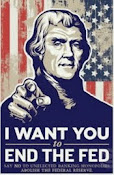 |
| http://endthefedusa.ning.com/ |
Wednesday, 16 November 2011
By George Smith
In his 1982 article, “Monetary Policy: Theory and Practice,” Nobel laureate Milton Friedman said that "if a domestic money consists of a commodity, a pure gold standard or cowrie bead standard, the principles of monetary policy are very simple. There aren’t any. The commodity money takes care of itself." [emphasis added]
It takes care of itself. Consider that thought for a moment, then ask yourself why we've had politically-appointed bureaucrats running the money and banking system since 1913. The "official" reason was to maintain the stability of the dollar and avoid the kind of panics that plagued the 19th century economy. But the dollar has all but dried up in value, and the crises today are threatening to bring the whole planet to its knees.
Does this mean Friedman was right, even if he was never gold's champion? Did commodity money keep economies in balance, both within and between nations?
Clearly, the views not only of central bankers but of their Keynesian supporters in the economics profession is, No, it didn't. Precious metal coins can't be printed, and accelerated printing - make that wildly accelerated printing - is needed at times to get banks and governments out of trouble.
Trying to run a fractional reserve banking system with gold as the medium is a real pain for politicians and bankers because of the handcuffs it imposes. To those at the top, gold's great flaw is its scarcity and lack of a "high elasticity of production," as Keynes informed us, meaning it can't be wished into existence. Since bankers fund governments in times of war, clearly gold is more than a mere inhibitor of profits; it represents a potential threat to national security. Anything that limits government action is regarded as a threat to its existence, and anything that threatens the existence of our masters threatens us, the argument goes.
Historically, of course, no government has allowed itself to be at the mercy of metal when it comes to waging war, at least not since paper IOUs began circulating for gold and silver. Belligerent governments in 1914 had little trouble going to war, putting gold on the sidelines as the slaughter mounted to settle the disagreements. But after the war there was still the lingering thought that gold somehow should still be money, and so the house of cards was restructured into something called the gold-exchange standard from 1926-1931. It took an ordinary recession amplified into a deep depression by government tampering to convince people that gold was unfit for societies run by a government - central bank alliance.
The hijacking of gold to serve special interests is one of the most consistent facts of human history. It's also one of the most difficult to believe because of what it implies about the leaders we've been trained to respect. Did Lincoln, Wilson, Roosevelt, Johnson, Bush, etc.. really lie us into war, then fund it with banker voodoo? We certainly won't learn that in government schools.
Sixty-three years ago Garet Garret told his readers:
There is a long history of monetary experience. It tells us that government is at heart a counterfeiter and therefore cannot be trusted to control money, and that this is true of both autocratic and popular government. The record has been cumulative since the invention of money. Nevertheless it is not believed. [emphasis added]
After the election of Ronald Reagan in late 1980 a joke circulated that went like this: "What's flat, black, and smokes?" Answer: Iran on Inauguration Day. Given the rhetoric in the air and the belligerent history of the past decade, the joke could be tomorrow's headline.
But not if politicians were handcuffed monetarily. Not if they couldn't get the Aladdin in charge of the Fed to fund their ambitions. Not if people start to believe that government counterfeiting is real and a threat to their lives.
My new Kindle ebook, The Jolly Roger Dollar: An Introduction to Monetary Piracy, addresses in detail the relationship between central banking and war, as well as many other issues, providing numerous hyperlinks to web resources as references for further reading.
-- Posted Wednesday, 16 November 2011
Source: GoldSeek.com